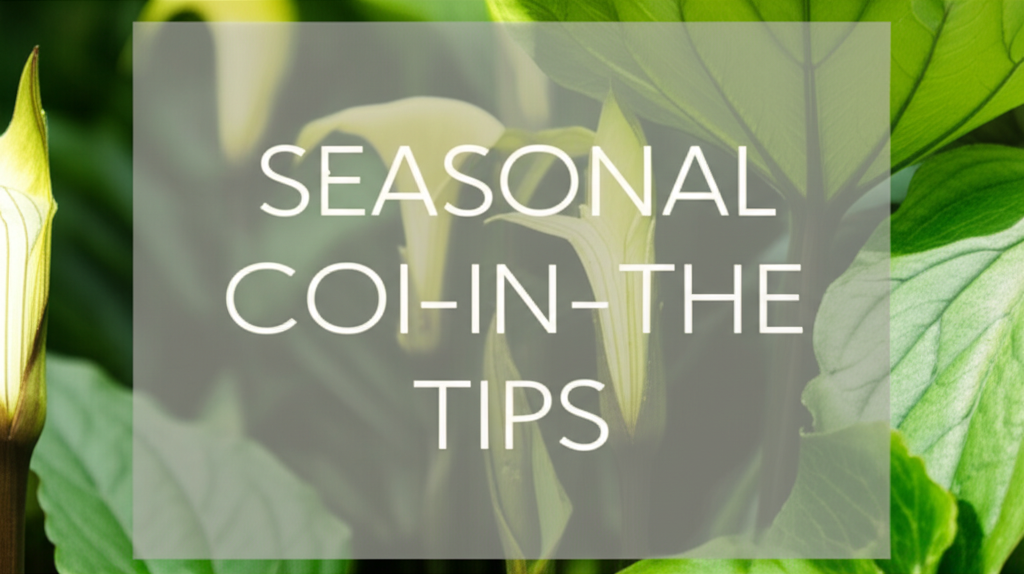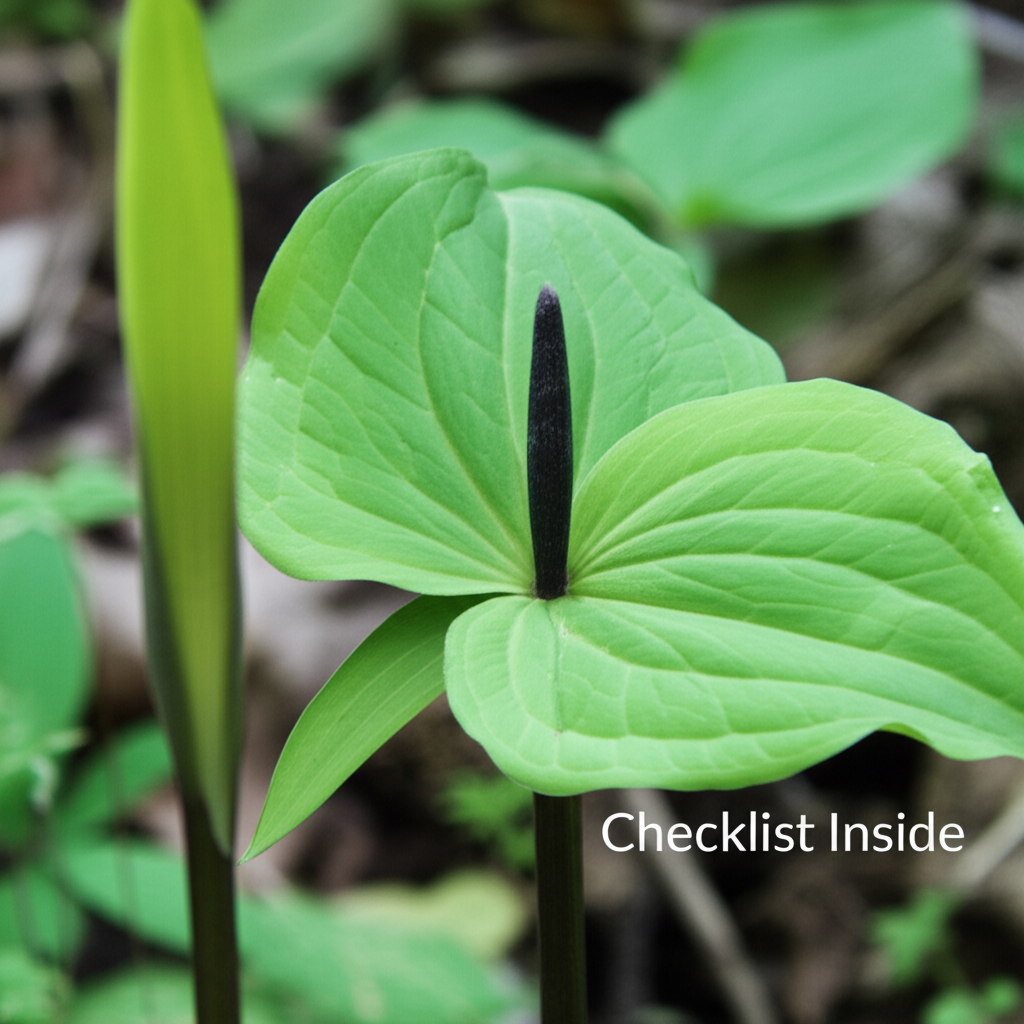Unveiling the Mystique of Jack-in-the-Pulpit: A Gardener’s Guide

Jack-in-the-Pulpit (Arisaema triphyllum) is a captivating woodland native that adds an air of mystery and intrigue to shaded garden corners. Its distinctive hooded spathe, often referred to as the “pulpit,” encloses a central spadix, or “Jack,” creating a unique floral structure. These fascinating plants are not just visually striking; they play an important role in their native ecosystems, supporting pollinators and offering berries to birds. However, to truly appreciate their beauty and ensure their thriving presence in your garden, understanding their seasonal needs is crucial. This comprehensive checklist will guide you through the year, providing the essential care steps to keep your Jack-in-the-Pulpit healthy, vigorous, and a consistent source of wonder.
Understanding the Jack-in-the-Pulpit’s Native Habitat
Before delving into seasonal care, it’s beneficial to understand where Jack-in-the-Pulpit naturally grows. They are typically found in moist, shady woodlands, often in rich, organic soil with good drainage. They thrive in dappled sunlight, similar to the conditions found beneath a forest canopy. Mimicking these conditions in your garden is the first and most crucial step to successful cultivation. They prefer slightly acidic to neutral soil pH. Their native range spans much of eastern North America.
Spring: Awakening from Dormancy and New Growth
As the last vestiges of winter recede and the soil begins to warm, Jack-in-the-Pulpit awakens from its dormant state. This is a critical period for providing the nourishment and support it needs for a productive growing season.
Emergence and Early Growth
- Observe for Shoots: Keep an eye on the forest floor or your shaded garden beds for the emergence of the characteristic unfurling leaves and the beginnings of the flower stalk. This usually occurs from late March to May, depending on your climate zone.
- Soil Moisture: Ensure the soil remains consistently moist but not waterlogged. The emerging growth is sensitive to drought. Water deeply if natural rainfall is insufficient.
- Mulching: If you haven’t already done so in the fall, apply a layer of organic mulch around the base of the plant. This helps retain moisture, suppress weeds, and regulate soil temperature. Good mulch options include shredded bark, compost, or leaf mold.
- Fertilization (Optional but Recommended): While Jack-in-the-Pulpit can survive without supplemental feeding, a light application of a balanced, slow-release organic fertilizer in early spring can provide a boost. Alternatively, a top dressing of compost or well-rotted manure will enrich the soil and provide nutrients. Avoid high-nitrogen fertilizers, which can lead to excessive leafy growth at the expense of flowers.
Flowering and Pollination
- The Spectacle: The iconic Jack-in-the-Pulpit flower will emerge and mature. The spathe typically opens, revealing the spadix within. This is the plant’s reproductive structure.
- Pollinators: While the flower’s primary purpose is reproduction, its unique structure also attracts specific pollinators, primarily small flies and gnats that become trapped within the spathe. This trapping mechanism ensures pollination occurs.
- Avoid Disturbing Flowers: It’s best to let nature take its course and avoid touching or disturbing the delicate flowers.
Summer: Maturation, Fruiting, and Continued Hydration
Summer is a period of growth and development for the Jack-in-the-Pulpit. The focus shifts to supporting the plant as it matures and, if conditions are favorable, produces its characteristic berry clusters.
Leaf Development and Photosynthesis
- Full Canopy: The leaves will reach their full size, providing shade to the developing corm and contributing to the plant’s overall health through photosynthesis.
- Consistent Moisture: Maintaining consistent soil moisture remains paramount. Periods of extreme dryness can stress the plant and affect future blooming. Water deeply when the top inch or two of soil feels dry.
- Weed Control: Continue to monitor for and remove any competing weeds. Weeds can steal valuable nutrients and moisture from your Jack-in-the-Pulpit.
- Pest and Disease Monitoring: While generally resilient, keep an eye out for common garden pests like slugs and snails, which can damage the foliage. Ensure good air circulation to minimize the risk of fungal diseases.
Berry Formation
- After Flowering: Once the flower has faded, a cluster of bright red berries will develop on the spadix. This is a beautiful and significant feature of the plant, providing a food source for wildlife.
- Ripening: The berries will ripen throughout the summer, becoming increasingly vibrant.
- Do Not Eat: It is crucial to note that the berries, and all parts of the Jack-in-the-Pulpit plant, are toxic if ingested due to the presence of calcium oxalate crystals. They can cause irritation and burning of the mouth and digestive tract.
Autumn: Preparing for Dormancy and Seed Dispersal
As the days shorten and temperatures cool, Jack-in-the-Pulpit begins its transition into dormancy. This is a time for the plant to store energy for the following year and for the gardener to prepare the bed for winter.
Leaf Senescence and Dieback
- Yellowing and Browning: The foliage will naturally begin to yellow and eventually die back. This is a normal process as the plant withdraws nutrients from the leaves into the underground corm.
- Allow Leaves to Decay: Resist the urge to cut back the foliage immediately. Allowing the leaves to naturally decay in place will return valuable nutrients to the soil and provide a protective layer.
- Seed Dispersal: Birds often feast on the ripe berries, aiding in seed dispersal. You may notice birds visiting your plants during this time.
Fall Mulching and Soil Enrichment
- Replenish Mulch: Once the foliage has completely died back, it’s an excellent time to replenish your mulch layer. This will insulate the corms from temperature fluctuations and prevent frost heaving. Aim for a layer of 2-3 inches.
- Compost Top-Dressing: Adding a layer of compost or well-rotted manure around the plant now will break down over winter, enriching the soil for spring.
- Consider Division (Every Few Years): If your Jack-in-the-Pulpit has become overcrowded or you wish to propagate more plants, fall is an ideal time to divide the corms. Carefully dig up the clumps, separate the corms, and replant them in well-prepared soil. Ensure each division has at least one healthy bud.
Winter: Dormancy and Rest
During the winter months, Jack-in-the-Pulpit rests, its energy conserved within the underground corm. While there is little active care required, understanding this dormant phase is key to appreciating its life cycle.
Underground Activity
- Corm Preservation: The corm is the energy storage organ of the plant. It is vital that the soil around it remains protected from extreme cold and thawing/freezing cycles, which is why fall mulching is so important.
- No Watering Needed: There is no need to water dormant plants.
- Protection from Disturbances: Avoid digging or disturbing the soil in the area where your Jack-in-the-Pulpit is growing during winter to prevent damage to the dormant corms.
Key Facts and Comparison: Jack-in-the-Pulpit vs. Other Woodland Natives
Understanding how Jack-in-the-Pulpit fits into a native woodland garden can inform your planting and care decisions. Here’s a comparison with other popular shade-loving plants:
| Feature | Jack-in-the-Pulpit (Arisaema triphyllum) | Foamflower (Tiarella cordifolia) | Wild Ginger (Asarum canadense) | Trillium (Trillium grandiflorum) |
|---|---|---|---|---|
| Sunlight | Part to Full Shade | Part to Full Shade | Part to Full Shade | Part to Full Shade |
| Soil Moisture | Moist, well-drained | Moist, well-drained | Moist, well-drained | Moist, well-drained |
| Soil Type | Rich, organic loam | Rich, organic loam | Rich, organic loam | Rich, organic loam |
| Bloom Time | Late Spring | Spring | Spring | Spring |
| Floral Display | Unique hooded spathe and spadix | Delicate, foamy white flower spikes | Small, star-shaped reddish-brown flowers at ground level | Large, showy white flower (can be pinkish) |
| Foliage | Trifoliate leaves, often mottled | Heart-shaped, lobed leaves, often attractive evergreen | Kidney-shaped, hairy leaves, evergreen | Three large, ovate leaves in a whorl |
| Height | 1-3 feet | 6-12 inches | 4-6 inches | 1-2 feet |
| Toxicity | Toxic (all parts) | Non-toxic | Non-toxic | Non-toxic |
| Seed Dispersal | Berries eaten by birds | Seed pods | Seed pods | Seed pods |
Troubleshooting Common Issues
Even with careful attention, occasional problems can arise. Here are some common issues and their solutions:
Leaf Spotting or Browning
- Cause: Often due to inconsistent watering (too dry or too wet), poor air circulation, or fungal issues.
- Solution: Ensure consistent moisture, improve air flow by spacing plants appropriately, and remove affected leaves promptly. Fungicides can be used as a last resort if the problem is severe and widespread.
Lack of Flowering
- Cause: Insufficient light, poor soil nutrition, or the plant is too young. Jack-in-the-Pulpit corms need to mature before they reliably flower.
- Solution: Ensure the plant is in a suitable shaded location with rich soil. A light feeding in spring might help. Be patient; it can take a few years for a corm to reach flowering size.
Pests (Slugs and Snails)
- Cause: These mollusks are attracted to tender foliage, especially in damp conditions.
- Solution: Handpick them off in the early morning or evening. Use slug bait (iron phosphate based is safer for pets and wildlife) or create beer traps. Ensure good air circulation to reduce damp environments.
Seasonal Care Checklist: A Step-by-Step Approach
This table summarizes the essential tasks for each season, making it easy to follow throughout the year.
| Season | Key Tasks | Pros | Cons |
|---|---|---|---|
| Spring | Observe for emergence, maintain soil moisture, mulch, optional light fertilization. | Encourages vigorous new growth and flowering. | Requires attention to emerging shoots and early moisture needs. |
| Summer | Maintain consistent moisture, weed control, monitor for pests and diseases, admire berry development. | Supports healthy foliage and potential berry production. | Requires consistent watering, especially during dry spells. |
| Autumn | Allow foliage to die back naturally, replenish mulch, top-dress with compost, consider division. | Prepares the plant for winter dormancy, enriches soil for next year. | Requires patience as foliage dies back; division can be a bit disruptive. |
| Winter | Dormancy; no active care required, protect from disturbance. | Allows the plant to rest and conserve energy. | Requires minimal intervention, but important to avoid disturbing the dormant corms. |
Cultivating a Thriving Jack-in-the-Pulpit Patch
Successfully growing Jack-in-the-Pulpit is a rewarding experience that connects you with the natural rhythms of the woodland ecosystem. By adhering to this seasonal care checklist, you can ensure these fascinating plants not only survive but flourish in your garden. Remember that consistency is key, particularly with soil moisture and providing the appropriate shaded environment. With a little planning and attention throughout the year, your Jack-in-the-Pulpit will continue to be a captivating highlight of your shaded garden, season after season. Embrace the unique beauty and ecological value of this extraordinary native plant.


